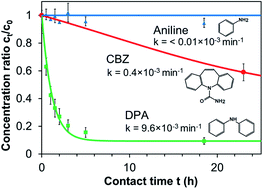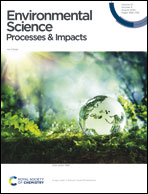The sorption behaviour of amine micropollutants on polyethylene microplastics – impact of aging and interactions with green seaweed†
Abstract
Microplastics are ubiquitous in the environment. Due to still rising global production, the emission of polymers into the environment and the abundance of microplastics have increased accordingly. Due to the long mineralization processes of microplastics, distribution in all compartments can be found. The hydrophobic surfaces of the particles can sorb chemical pollutants, therefore providing a potential pathway to accumulation by organisms within the food web. However, little is known about how long-term aging and degradation processes of microplastics can affect the sorption behaviours of organic pollutants on the particles. In this study, important industrial additives of emerging environmental concern, such as hydrophobic aromatic amines, were studied in relation to their sorption behaviour on high-density polyethylene and low-density polyethylene microplastics. Diphenylamine (log POW (logarithmic octanol–water partition coefficient) = 3.5) showed strong sorption, carbamazepine (log POW = 2.5) showed moderate sorption, and aniline (log POW = 0.9) showed no detectable sorption behaviour. Artificially aged particles exposed to photochemical aging and long-term mechanical treatment in water were compared to pristine microplastics. While mechanically aged microplastics promoted the sorption of aromatic amines, photochemically aged particles showed a decrease in sorption capacity due to changed surface chemistry. Importantly, the sorption capacity increased with increasing salinity, leading to strong implications for ocean systems, as an elevated uptake of pollutants could occur under marine conditions. Moreover, our study demonstrates that the ecotoxicological effects of diphenylamine on the growth of the seaweed Ulva (sea lettuce, Chlorophyta) were reduced in the presence of microplastics. As the plastic particles withdrew enough contaminants from solution, even toxic levels of diphenylamine (c = 10−4 M) became tolerable for the algae. However, the pollutants initially sorbed on the microplastics can be released again at a later point in the ageing process, thus having delayed pollution potential.

- This article is part of the themed collections: Environmental exposure and impacts and SDG14: Life Below Water – Marine Litter (Plastics and Pollution)


 Please wait while we load your content...
Please wait while we load your content...